Exploiting High Resolution Multi-Seasonal Textural Measures and Spectral Information for Reedbed Mapping
Abstract
:1. Introduction
- (1)
- to determine the most effective single-date (autumn or summer) and multi-seasonal QuickBird imagery suitable for reedbed mapping over the study area;
- (2)
- to evaluate the effectiveness of combining multi-seasonal texture measures and spectral information for reedbed mapping using a variety of combinations; and
- (3)
- to evaluate the most suitable classification technique for reedbed mapping from three selected classification techniques, namely maximum likelihood classifier, spectral angular mapper and artificial neural network back propagation technique.
2. Materials and Methods
2.1. Study Areas
2.2. Satellite Image Acquisition and Processing
2.3. Texture Measures Calculation
2.4. Texture Measures Calculation
2.5. Evaluating Image Classification Techniques for Reedbed Mapping
2.6. Accuracy Assessment
3. Results and Discussion
3.1. Single-Date Classification Accuracies
3.2. Comparison of MLC Single-Date and Multi-Seasonal Classification Accuracies
3.3. Comparison of Classification Techniques Using Optimal Multi-Seasonal Dataset
3.4. Inventory of Mapped Reedbed Habitats
4. Conclusions
Acknowledgments
Author Contributions
Conflicts of Interest
References
- Goetz, S.J.; Wright, R.K.; Smith, A.J.; Zinecker, E.; Schaub, E. Ikonos imagery for resource management: Tree cover, impervious surfaces, and riparian buffer analyses in the mid-atlantic region. Remote Sens. Environ. 2003, 88, 195–208. [Google Scholar] [CrossRef]
- Laba, M.; Downs, R.; Smith, S.; Welsh, S.; Neider, C.; White, S.; Richmond, M.; Philpot, W.; Baveye, P. Mapping invasive wetland plants in the Hudson River National Estuarine Research Reserve using Quickbird satellite imagery. Remote Sens. Environ. 2008, 112, 286–300. [Google Scholar] [CrossRef]
- Lawrence, R.; Hurst, R.; Weaver, T.; Aspinall, R. Mapping prairie pothole communities with multitemporal IKONOS satellite imagery. Photogramm. Eng. Remote Sens. 2006, 72, 169–174. [Google Scholar] [CrossRef]
- Wang, L.; Sousa, W.P.; Gong, P.; Biging, G.S. Comparison of ikonos and Quickbird images for mapping mangrove species on the Caribbean coast of Panama. Remote Sens. Environ. 2004, 91, 432–440. [Google Scholar] [CrossRef]
- Wolter, P.T.; Johnston, C.A.; Niemi, G.J. Mapping submergent aquatic vegetation in the US Great Lakes using Quickbird satellite data. Int. J. Remote Sens. 2005, 26, 5255–5274. [Google Scholar] [CrossRef]
- Mas, J.F.; Flores, J.J. The application of artificial neural networks to the analysis of remotely sensed data. Int. J. Remote Sens. 2008, 29, 617–663. [Google Scholar] [CrossRef]
- Guerschman, J.P.; Paruelo, J.M.; Di Bella, C.; Giallorenzi, M.C.; Pacin, F. Land cover classification in the argentine pampas using multi-temporal landsat TM data. Int. J. Remote Sens. 2003, 24, 3381–3402. [Google Scholar] [CrossRef]
- Brisco, B.; Browm, R.J. Multidate SAR/TM synergism for crop classification in western Canada. Photogramm. Eng. Remote Sens. 1995, 61, 1009–1014. [Google Scholar]
- Conese, C.; Maselli, F. Use of multi temporal information to improve classification performance of TM scenes in complex terrain. ISPRS J. Photogramm. Remote Sens. 1991, 46, 187–197. [Google Scholar] [CrossRef]
- Davranche, A.; Lefebvre, G.; Poulin, B. Wetland monitoring using classification trees and SPOT-5 seasonal time series. Remote Sens. Environ. 2010, 114, 552–562. [Google Scholar] [CrossRef]
- Liu, X.-H.; Skidmore, A.K.; van Oosten, H. Integration of classification methods for improvement of land-cover map accuracy. ISPRS J. Photogramm. Remote Sens. 2002, 56, 257–268. [Google Scholar] [CrossRef]
- Lunetta, R.S.; Balogh, M.E. Application of multi-temporal landsat 5 TM imagery for wetland identification. Photogramm. Eng. Remote Sens. 1999, 65, 1303–1310. [Google Scholar]
- Murthy, C.S.; Raju, P.V.; Badrinath, K.V.S. Classification of wheat crop with multi-temporal images: Performance of maximum likelihood and artificial neural networks. Int. J. Remote Sens. 2003, 24, 4871–4890. [Google Scholar] [CrossRef]
- Nageswara, R.P.; Mohan, K.A. Rice crop identification and area estimation using remotely sensed data from Indian cropping patterns. Int. J. Remote Sens. 1987, 8, 639–650. [Google Scholar]
- Oetter, D.R.; Cohen, W.B.; Berterretche, M.; Maiersperger, T.K.; Kennedy, R.E. Land cover mapping in an agricultural setting using multiseasonal thematic mapper data. Remote Sens. Environ. 2000, 76, 139–155. [Google Scholar] [CrossRef]
- Vieira, C.A.O.; Mather, P.M.; Mccullagh, M. The spectral temporal response surface and its use in the multi sensor, multi temporal classification of agricultural crops. In XIX ISPRS: IAPRS; ISPRS: Amsterdam, The Netherlands, 2000; Volume XXXIII. [Google Scholar]
- Haralick, R.M. Statistical and structural approaches to texture. Syst. Man Cybern. IEEE Trans. Syst. 1979, 67, 786–804. [Google Scholar] [CrossRef]
- Haralick, R.M.; Shanmugam, K.; Dinstein, I. Textural features for image classification. Syst. Man Cybern. IEEE Trans. Syst. 1973, 3, 610–621. [Google Scholar] [CrossRef]
- Berberoglu, S.; Curran, P.J. Merging spectral and textural information for classifying remotely sensed images. In Remote Sensing Image Analysis: Including the Spatial Domain; Steven, M.J., Freek, D.M., Eds.; Kluwer Academic: Dordrecht, The Netherlands; Boston, MA, USA; London, UK, 2004; Volume 5, pp. 113–136. [Google Scholar]
- Berberoglu, S.; Curran, P.J.; Lloyd, C.D.; Atkinson, P.M. Texture classification of mediterranean land cover. Int. J. Appl. Earth Observ. Geoinform. 2007, 9, 322–334. [Google Scholar] [CrossRef]
- Dikshit, O. Textural classification for ecological research using ATM images. Int. J. Remote Sens. 1996, 17, 887–915. [Google Scholar] [CrossRef]
- Franklin, S.E.; Hall, R.J.; Moskal, L.M.; Maudie, A.J.; Lavigne, M.B. Incorporating texture into classification of forest species composition from airborne multispectral images. Int. J. Remote Sens. 2000, 21, 61–79. [Google Scholar] [CrossRef]
- Franklin, S.E.; Maudie, A.J.; Lavigne, M.B. Using spatial co-occurence texture to increase forest structure and species composition classification accuracy. Photogramm. Eng. Remote Sens. 2001, 67, 849–855. [Google Scholar]
- Hudak, A.T.; Wessman, C.A. Textural analysis of high resolution imagery to quantify bush encroachment in madikwe game reserve, South Africa, 1955–1996. Int. J. Remote Sens. 2001, 22, 2731–2740. [Google Scholar] [CrossRef]
- Pearlstine, L.; Portier, K.M.; Smith, S.E. Textural discrimination of an invasive plant, Schinus terebinthifolius, from low altitude aerial digital imagery. Photogramm. Eng. Remote Sens. 2005, 71, 289–298. [Google Scholar] [CrossRef]
- Tsai, F.; Ming Jhong, C. Texture augmented analysis of high resolution satellite imagery in detecting invasive plant species. J. Chin. Inst. Eng. 2006, 29, 581–592. [Google Scholar] [CrossRef]
- Tsai, F.; Ming Jhong, C.; Wang, H.H. Texture analysis of high resolution satellite imagery for mapping invasive plants. In Proceedings of the International Geoscience and Remote Sensing Symposium (IGARSS’05), Seoul, Korea, 25–29 July 2005; IEEE International: Seoul, Korea; pp. 3024–3027.
- Onojeghuo, A.O.; Blackburn, G.A. Mapping reedbed habitats using texture based classification of Quickbird imagery. Int. J. Remote Sens. 2011, 32, 8121–8138. [Google Scholar] [CrossRef]
- Richards, J.A. Thematic mapping from multitemporal image data using the principal components transformation. Remote Sens. Environ. 1984, 16, 35–46. [Google Scholar] [CrossRef]
- Girouard, G.; Bannari, A.; El Harti, A.; Desrochers, A. Validated spectral angle mapper algorithm for geological mapping: Comparative study between Quickbird and Landsat-TM. In XXth ISPRS Congress; Geo-Imagery Bridging Continents: Istanbul, Turkey, 2004. [Google Scholar]
- Kruse, F.A.; Boardman, J.W.; Lefkoff, A.B.; Heidebrecht, K.B.; Shapiro, A.T.; Barloon, P.J.; Goetz, A.F.H. The spectral image processing system (SIPS)—Interactive visualization and analysis of imaging spectrometer data. Remote Sens. Environ. 1993, 44, 145–163. [Google Scholar] [CrossRef]
- Sohn, Y.; Moran, E.; Gurri, F. Deforestation in North-Central Yucatan (1985–1995): Mapping secondary succession of forest and agricultural land use in Sotuta using the cosine of the angle concept. Photogramm. Eng. Remote Sens. 1999, 65, 947–958. [Google Scholar]
- Sohn, Y.; Rebello, N.S. Supervised and unsupervised spectral angle classifiers. Photogramm. Eng. Remote Sens. 2002, 68, 1271–1281. [Google Scholar]
- Yuhas, R.H.; Goetz, A.F.H.; Boardman, J.W. Discrimination among semi-arid landscape endmembers using the spectral angle mapper (SAM) algorithm. In Summaries of the 4th JPL Airborne Earth Science Workshop; Green, R.O., Ed.; JPL Publication: Pasadena, CA, USA, 1992; Volume 92–14, pp. 147–149. [Google Scholar]
- Ouyang, Z.-T.; Gao, Y.; Xie, X.; Guo, H.-Q.; Zhang, T.-T.; Zhao, B.; Convertino, M. Spectral discrimination of the invasive plant spartina alterniflora at multiple phenological stages in a saltmarsh wetland. PLoS ONE 2013, 8. [Google Scholar] [CrossRef] [PubMed]
- Chavez, P.S. An improved dark-object subtraction technique for atmospheric scattering correction of multispectral data. Remote Sens. Environ. 1988, 24, 459–479. [Google Scholar] [CrossRef]
- ERDAS. Erdas Imagine 2014; Hexagon Geospatial: Norcross, GA, USA, 2014. [Google Scholar]
- Congalton, R.G.; Green, K. Assessing the Accuracy of Remotely Sensed Data: Principles and Practice; CRC Press/Taylor & Francis: Boca Raton, FL, USA, 2009. [Google Scholar]
- Stehman, S.V.; Czaplewski, R.L. Design and analysis for thematic map accuracy assessment: Fundamental principles. Remote Sens. Environ. 1998, 64, 331–344. [Google Scholar] [CrossRef]
- Bishop, C.M. Neural Networks for Pattern Recognition; Clarendon Press, Oxford University Press: Oxford, NY, USA, 1995. [Google Scholar]
- Cohen, J. A coefficient of agreement of nominal scales. Educ. Psychol. Meas. 1960, 20, 37–46. [Google Scholar] [CrossRef]
- Congalton, R.G. A review of assessing the accuracy of classifications of remotely sensed data. Remote Sens. Environ. 1991, 37, 35–46. [Google Scholar] [CrossRef]
- Congalton, R.G.; Oderwald, R.G.; Mead, R.A. Assessing landsat classification accuracy using discrete multivariate analysis statistical techniques. Photogramm. Eng. Remote Sens. 1983, 49, 1671–1678. [Google Scholar]
- Dwivedi, R.S.; Kandrika, S.; Ramana, K.V. Comparison of classifiers of remote-sensing data for land-use/land-cover mapping. Curr. Sci. 2003, 86, 328–335. [Google Scholar]
- Murakami, T. Seasonal variation in classification accuracy of forest-cover types examined by single band or band combinations. J. For. Res. 2004, 9, 211–215. [Google Scholar] [CrossRef]
- Franklin, S.E.; Wulder, M.A.; Gerylo, G.R. Texture analysis of IKONOS panchromatic data for Douglas-fir forest age class separability in British Columbia. Int. J. Remote Sens. 2001, 22, 2627–2632. [Google Scholar] [CrossRef]
- Helmer, E.H.; Brown, S.; Cohen, W.B. Mapping montane tropical forest successional stage and land use with multi-date landsat imagery. Int. J. Remote Sens. 2000, 21, 2163–2183. [Google Scholar] [CrossRef]
- Liu, Q.J.; Takamura, T.; Takeuchi, N.; Shao, G. Mapping of boreal vegetation of a temperate mountain in China by multitemporal Landsat TM imagery. Int. J. Remote Sens. 2002, 23, 3385–3405. [Google Scholar] [CrossRef]
- Dai, L.; Liu, C. Multiple classifier combination for land cover classification of remote sensing image. In Proceedings of the 2010 2nd International Conference on Information Science and Engineering (ICISE), Hangzhou, China, 4–6 December 2010; pp. 3835–3839.
- Laba, M.; Blair, B.; Downs, R.; Monger, B.; Philpot, W.; Smith, S.; Sullivan, P.; Baveye, P.C. Use of textural measurements to map invasive wetland plants in the Hudson River National Estuarine Research Reserve with IKONOS satellite imagery. Remote Sens. Environ. 2010, 114, 876–886. [Google Scholar] [CrossRef]
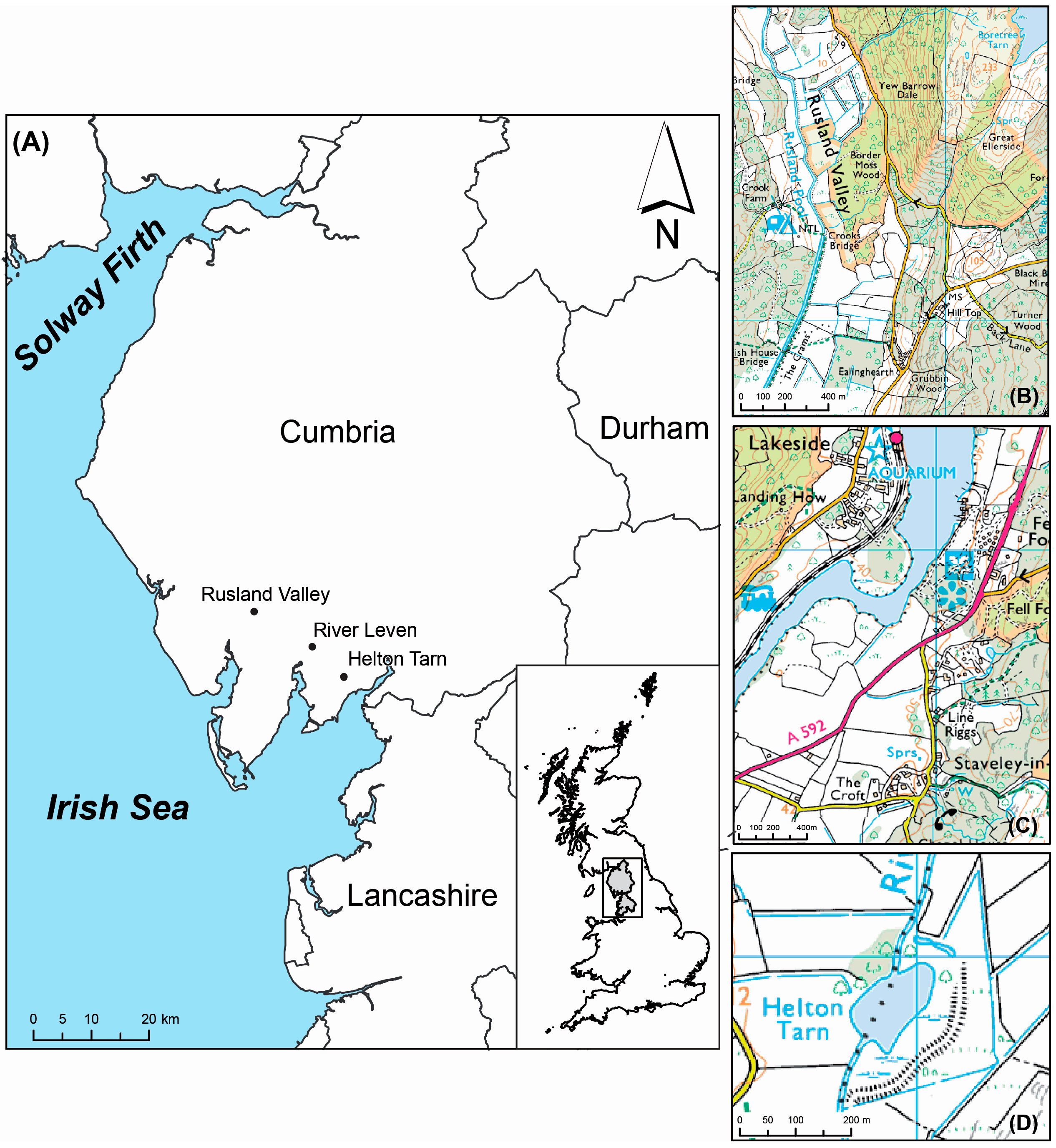

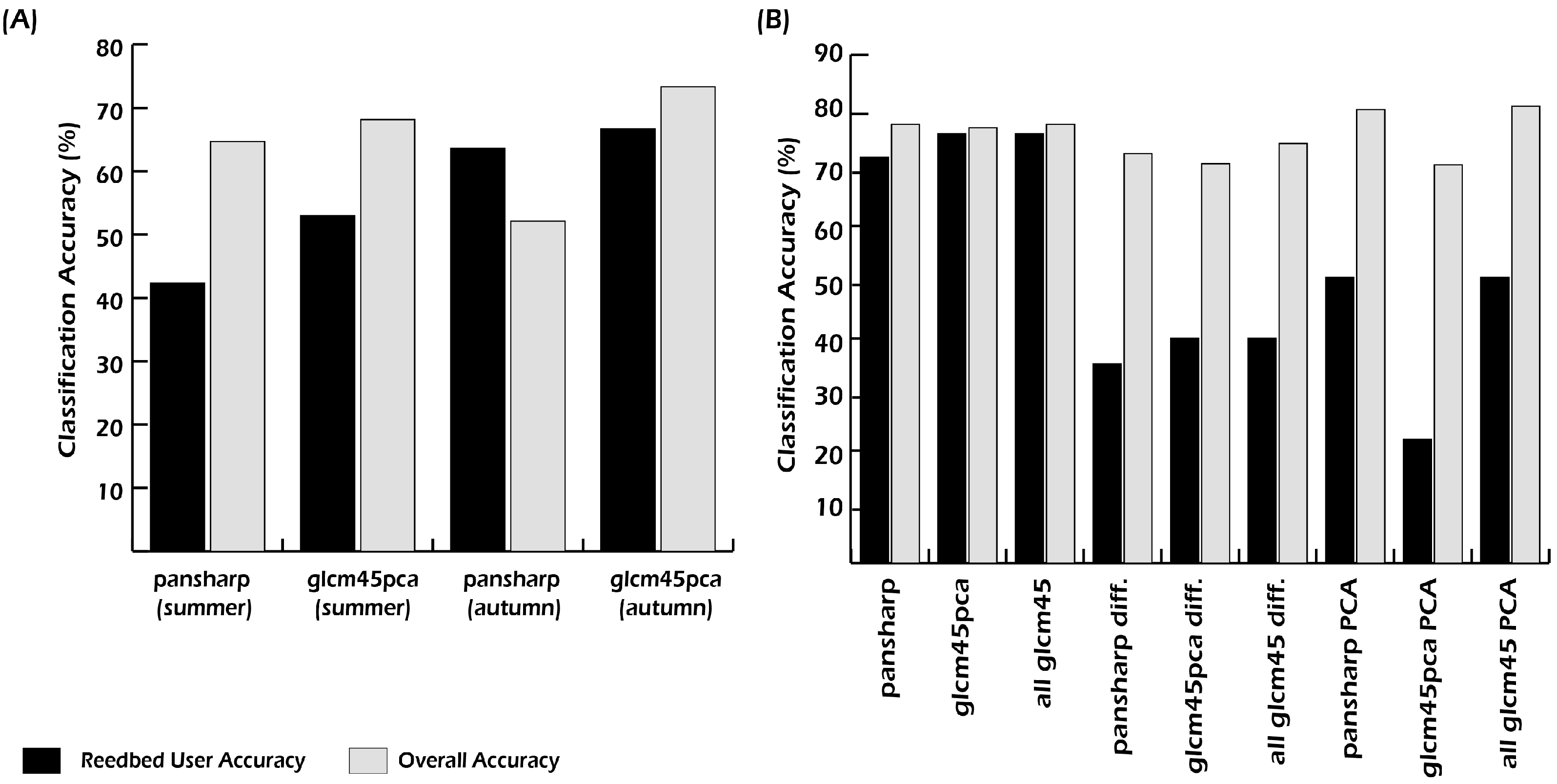
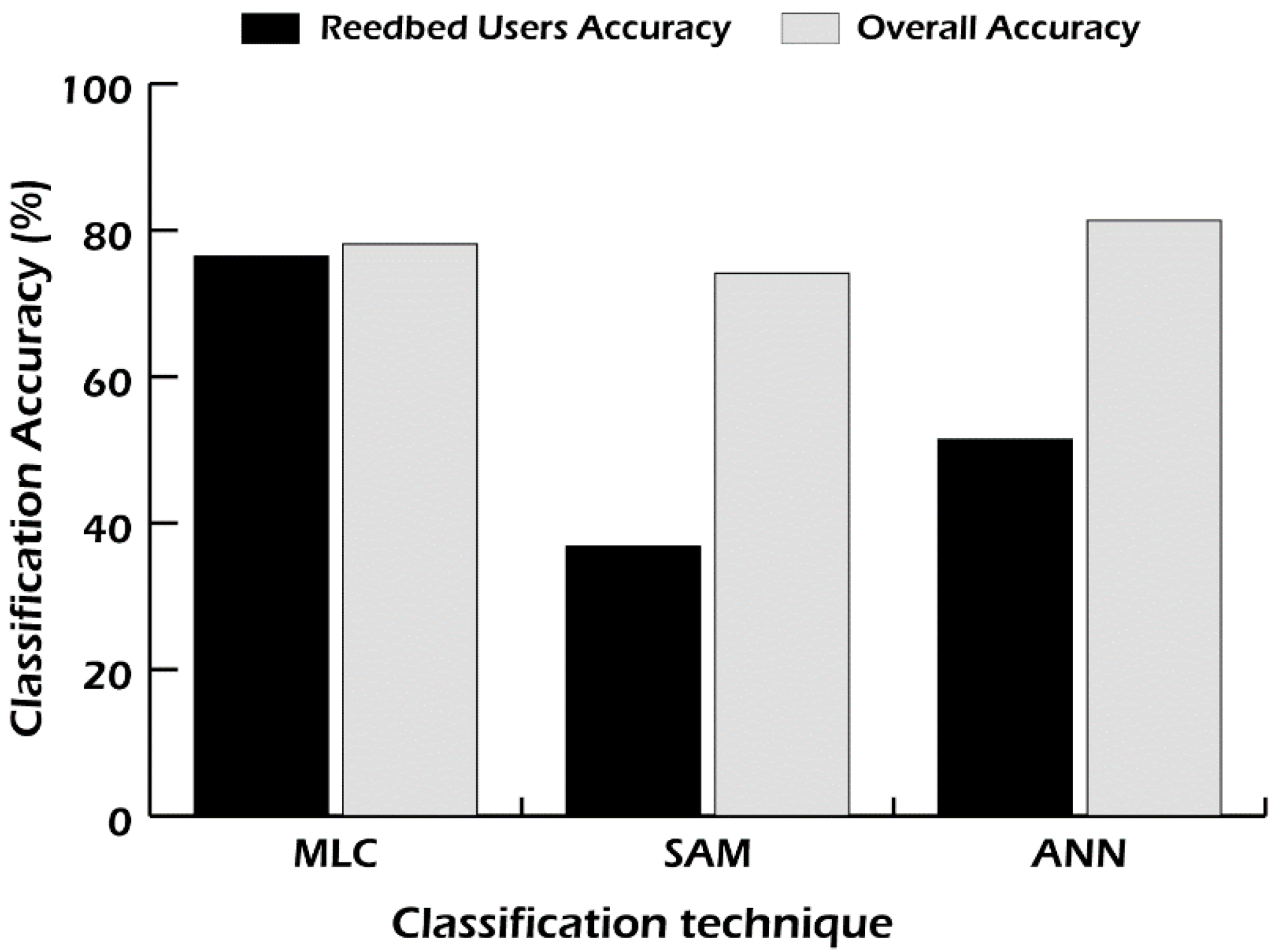
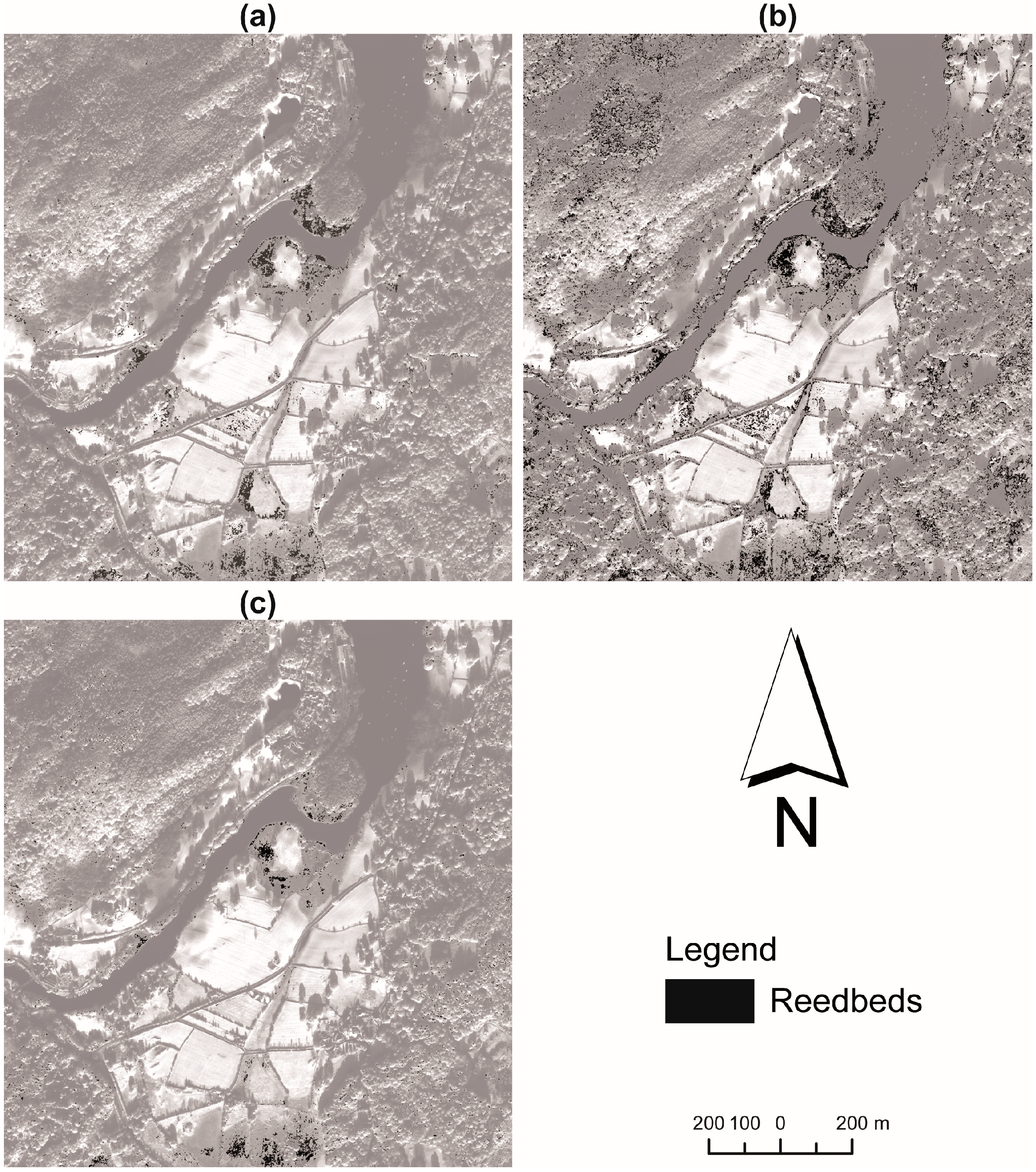
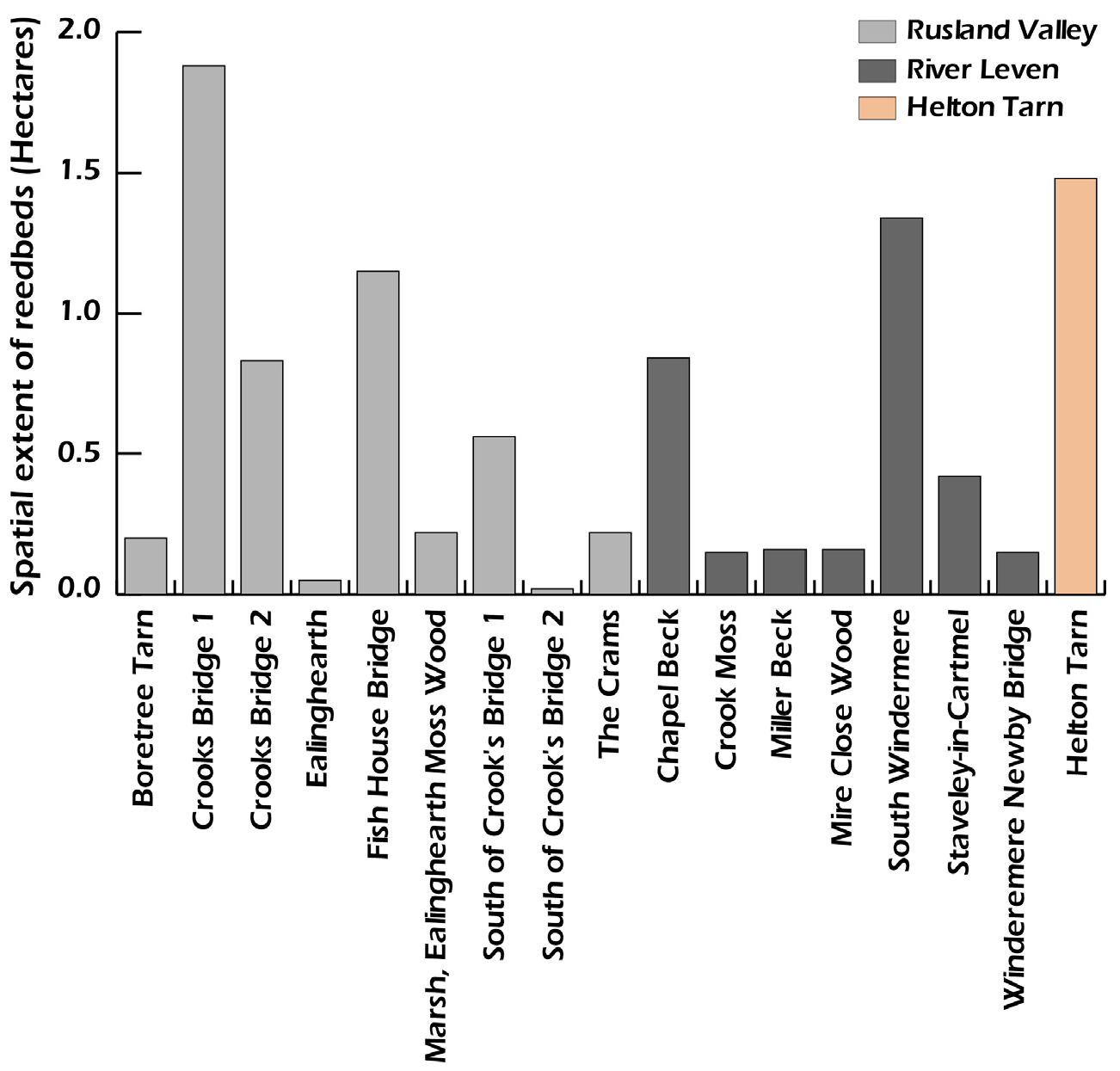
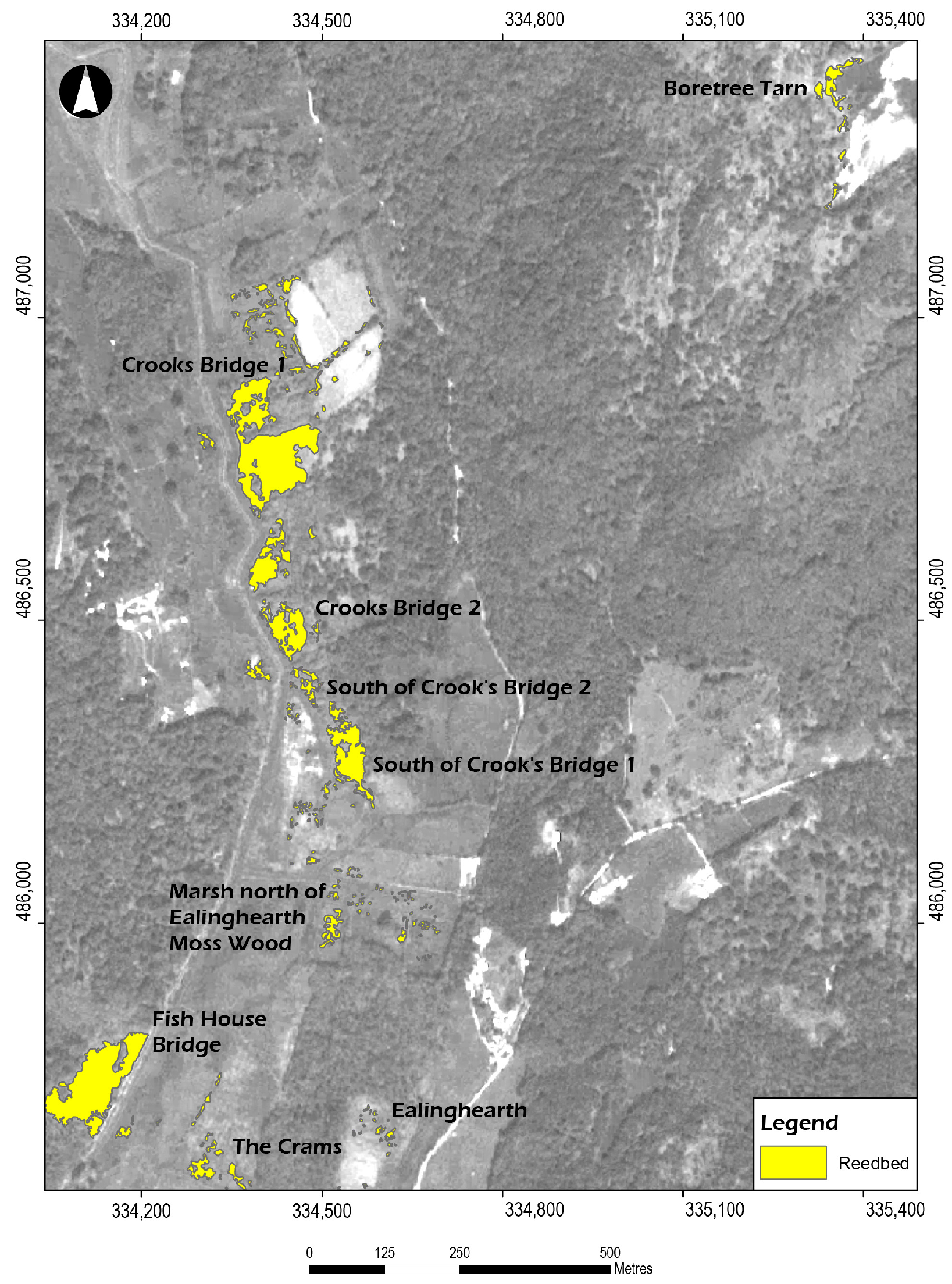
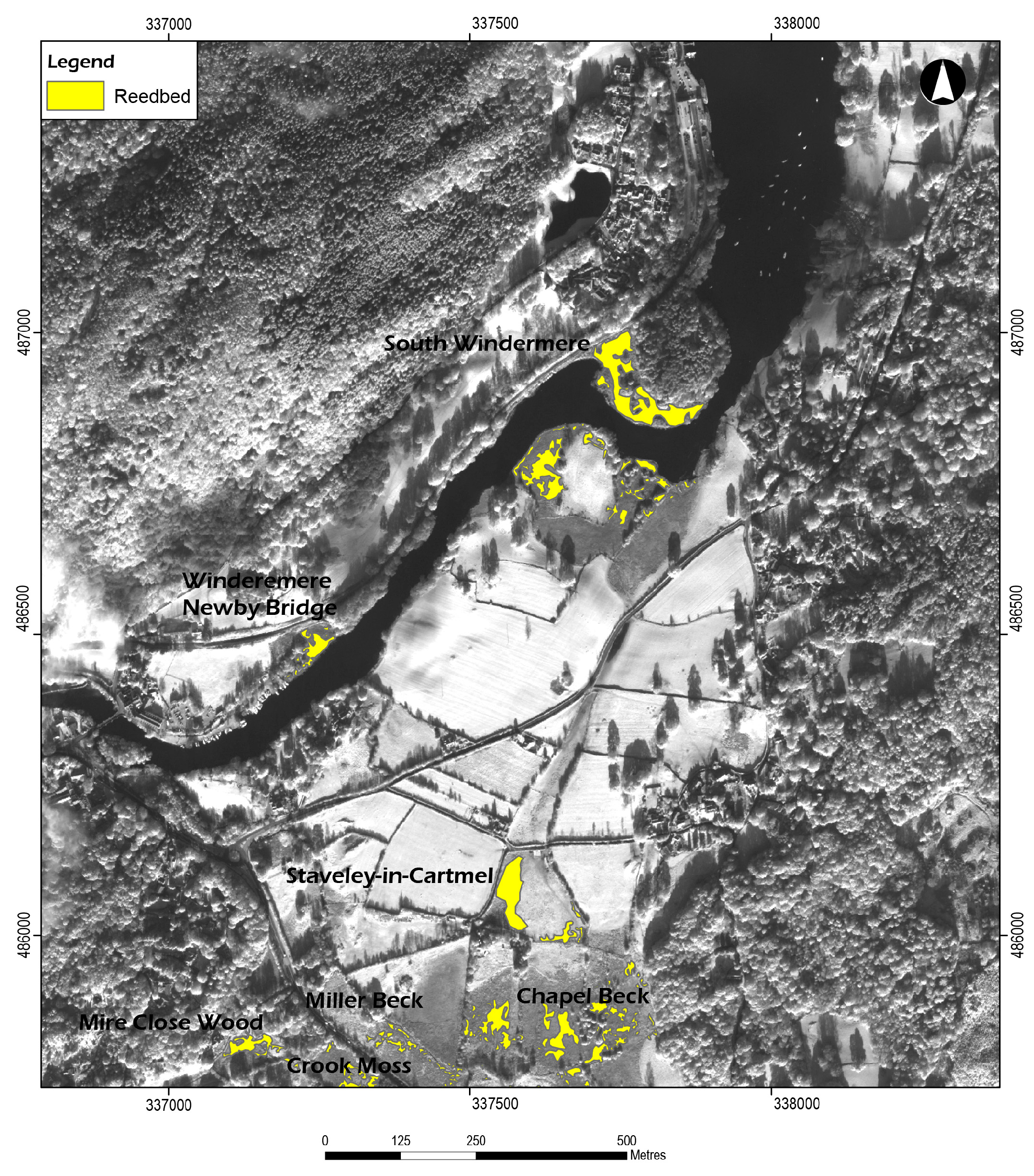
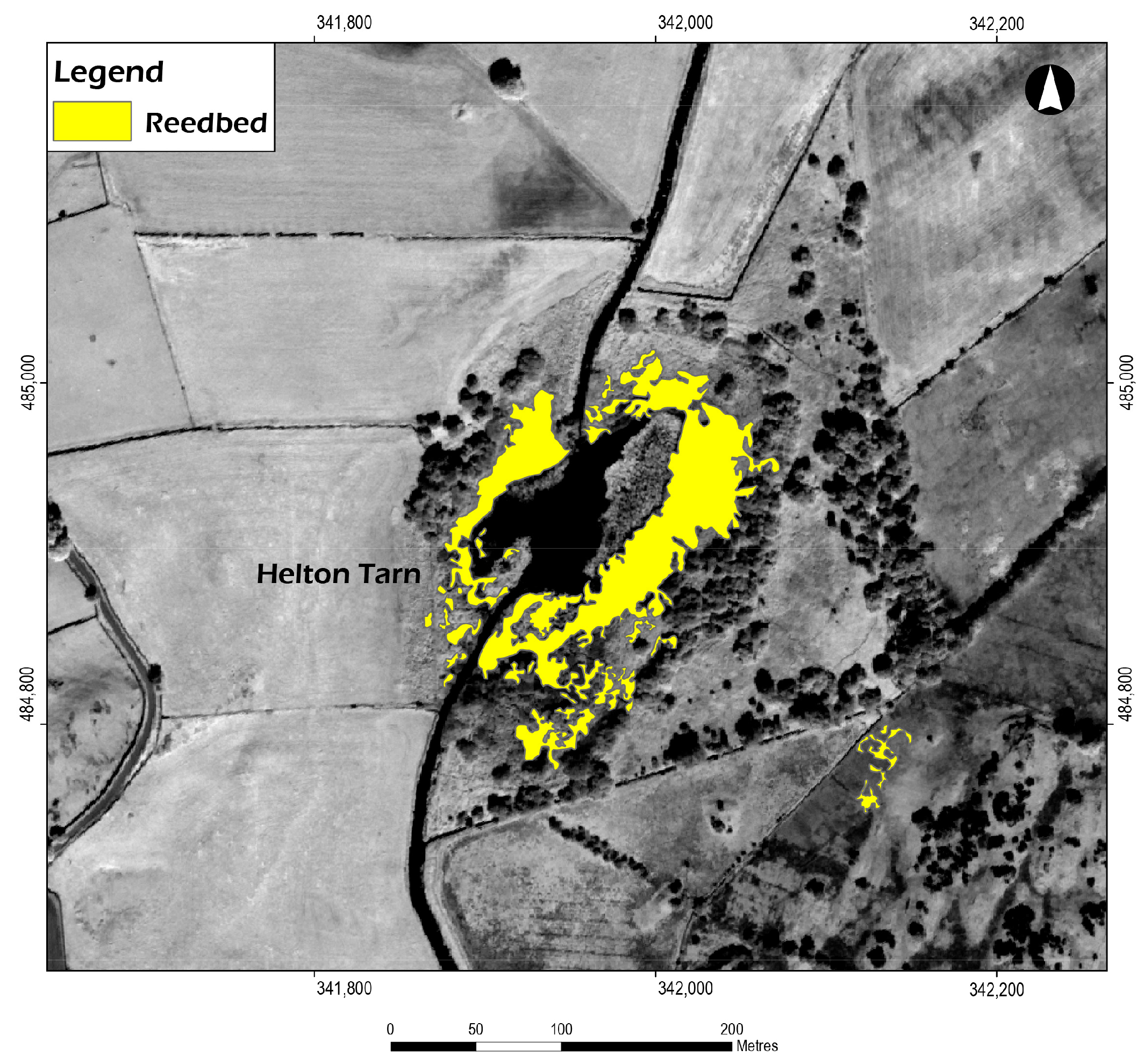
| Image Dataset | Description | Number of Bands |
|---|---|---|
| pansharp MS (single-date) | Multispectral bands only (summer and autumn separately) | 4 |
| glcm45pca (single-date) | Multispectral bands combined with principal components 1–2 of GLCM entropy and angular second moment computed using windows 3 × 3 and 7 × 7 (autumn and winter) | 6 |
| pansharp | Combination of multispectral bands for autumn and summer QB images. | 8 |
| glcm45pca | Combination of eight multispectral bands and principal components 1–4 of GLCM texture measures (entropy and angular second moment computed using windows 3 × 3 and 7 × 7) for autumn and summer QB images | 12 |
| all glcm45 | Combination of 8 pansharpened multispectral bands and 8 GLCM texture measures (entropy and angular second moment computed using windows 3 × 3 and 7 × 7) for autumn and summer QB images | 16 |
| pansharp difference | Image difference of autumn and summer pansharpened multispectral images. | 4 |
| glcm45pca difference | Image difference of autumn and summer pansharpened and texture combined image datasets | 6 |
| all glcm45 difference | Image difference of autumn and summer datasets each having four spectral and four GLCM texture measures—entropy and angular second moment computed using windows 3 × 3 and 7 × 7 | 8 |
| pansharp PCA | First 3 principal components of spectral bands for both dates | 3 |
| glcm45pca PCA | First 3 principal components of autumn and summer datasets—glcm45pca | 3 |
| all glcm45 PCA | First 3 principal components of autumn and summer datasets—all glcm45 | 3 |
| Image Dataset | Classified Total | Number Correct | Reedbed PA | Reedbed UA | Overall Accuracy | Reedbed Kappa | Overall Kappa |
|---|---|---|---|---|---|---|---|
| pansharp (summer) | 26 | 11 | 32.35 | 42.31 | 64.68 | 0.38 | 0.53 |
| glcm45pca (summer) | 17 | 9 | 26.47 | 52.94 | 68.14 | 0.5 | 0.58 |
| pansharp (autumn) | 22 | 14 | 41.18 | 63.64 | 52.12 | 0.61 | 0.4 |
| glcm45pca (autumn) | 6 | 4 | 11.76 | 66.67 | 73.34 | 0.65 | 0.66 |
| Class | Error Matrix | KAPPA Statistics | Variance |
| Reedbed only | pansharp (summer)-(SP) | 0.2490 | 0.000492101 |
| glcm45pca (summer)-(SP+T) | 0.3901 | 0.000446294 | |
| pansharp (autumn)-(AP) | 0.4075 | 0.000495398 | |
| glcm45pca (autumn)-(AP+T) | 0.5110 | 0.000438014 | |
| Overall class | pansharp (summer) | 0.6485 | 0.000492101 |
| glcm45pca (summer) | 0.7124 | 0.000446294 | |
| pansharp (autumn) | 0.6512 | 0.000495398 | |
| glcm45pca (autumn) | 0.7160 | 0.000438014 | |
| Class | Pairwise Comparison | Z Statistics | Confidence Level (%) |
| Reedbed only | SP vs. (SP+T) | −4.6061 | 99% significant |
| AP vs. (AP+T) | −3.3877 | 99% significant | |
| SP vs. AP | 5.0438 | 99% significant | |
| (AP+T) vs. (SP+T) | 4.0656 | 99% significant | |
| Overall class | SP vs. (SP+T) | −2.0860 | 95% significant |
| AP vs. (AP+T) | −2.1210 | 95% significant | |
| AP vs. SP | 0.0859 | Not significant. | |
| (AP+T) vs. (SP+T) | 0.1211 | Not significant |
| Image Dataset | Total | Correct | R-PA | R-UA | OA | R-KP | O-KP | Number |
|---|---|---|---|---|---|---|---|---|
| pansharp | 18 | 13 | 38.24 | 72.22 | 78.11 | 0.7 | 0.7 | 8 |
| glcm45pca | 17 | 13 | 38.24 | 76.47 | 77.51 | 0.69 | 0.75 | 12 |
| all glcm45 | 17 | 13 | 38.24 | 76.47 | 78.11 | 0.7 | 0.75 | 16 |
| pansharp difference | 31 | 11 | 32.35 | 35.48 | 72.89 | 0.63 | 0.31 | 8 |
| glcm45pca difference | 35 | 14 | 41.18 | 40 | 71.08 | 0.6 | 0.36 | 6 |
| all glcm45 difference | 40 | 16 | 47.06 | 40 | 74.7 | 0.66 | 0.36 | 8 |
| pansharp PCA | 61 | 31 | 91.18 | 50.82 | 80.72 | 0.76 | 0.47 | 3 |
| glcm45pca PCA | 59 | 13 | 38.24 | 22.03 | 70.88 | 0.64 | 0.16 | 3 |
| all glcm45 PCA | 61 | 31 | 91.18 | 50.82 | 81.33 | 0.76 | 0.47 | 3 |
| Class | Error Matrix | KAPPA Statistics | Variance |
| Reedbed only | MLC | 0.7186 | 0.0003620 |
| ANN | 0.5878 | 0.0003101 | |
| SAM | 0.5094 | 0.0004674 | |
| Overall class | MLC | 0.7988 | 0.0003620 |
| ANN | 0.8253 | 0.0003101 | |
| SAM | 0.7110 | 0.0004674 | |
| Class | Pairwise Comparison | Z Statistics | Confidence Level (%) |
| Reedbed only | MLC vs. ANN | 5.0454 | 99% significant |
| MLC vs. SAM | 2.8116 | 99% significant | |
| ANN vs. SAM | 2.8116 | 99% significant | |
| Overall class | MLC vs. ANN | −1.0222 | Not significant |
| MLC vs. SAM | 4.0990 | 99% significant | |
| ANN vs. SAM | 4.0990 | 99% significant |
© 2016 by the authors; licensee MDPI, Basel, Switzerland. This article is an open access article distributed under the terms and conditions of the Creative Commons by Attribution (CC-BY) license (http://creativecommons.org/licenses/by/4.0/).
Share and Cite
Onojeghuo, A.O.; Blackburn, G.A. Exploiting High Resolution Multi-Seasonal Textural Measures and Spectral Information for Reedbed Mapping. Environments 2016, 3, 5. https://doi.org/10.3390/environments3010005
Onojeghuo AO, Blackburn GA. Exploiting High Resolution Multi-Seasonal Textural Measures and Spectral Information for Reedbed Mapping. Environments. 2016; 3(1):5. https://doi.org/10.3390/environments3010005
Chicago/Turabian StyleOnojeghuo, Alex Okiemute, and George Alan Blackburn. 2016. "Exploiting High Resolution Multi-Seasonal Textural Measures and Spectral Information for Reedbed Mapping" Environments 3, no. 1: 5. https://doi.org/10.3390/environments3010005
APA StyleOnojeghuo, A. O., & Blackburn, G. A. (2016). Exploiting High Resolution Multi-Seasonal Textural Measures and Spectral Information for Reedbed Mapping. Environments, 3(1), 5. https://doi.org/10.3390/environments3010005





